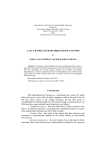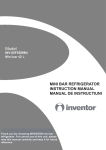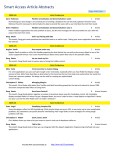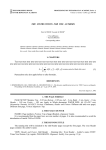Download DESIGNING A DRIP IRRIGATION SYSTEM USING
Transcript
Research Journal of Agricultural Science, 41 (1), 2009 DESIGNING A DRIP IRRIGATION SYSTEM USING HYDROCALC IRRIGATION PLANNING PROIECTAREA UNUI SISTEM DE IRIGAŢII PRIN PICURARE UTILIZÂND PROGRAMUL HYDROCALC Rareş HĂLBAC-COTOARĂ-ZAMFIR „Politehnica” University of Timişoara 2nd Victoriei Square, 300006, Timişoara, [email protected] Abstract: The competitive demand of available water is more and more acute now in most parts of the world. The supplies of good water quality are declining every day. It is, therefore, necessary to find methods to improve water use efficiency in agriculture. The drip irrigation is one of the most efficient irrigation systems that are used in agriculture. HydroCalc Irrigation Planning is software for the irrigation community. It is a simple and easy calculation tool to perform some basic hydraulic computations. The use of HydroCalc allows the designer, dealer or end-user to evaluate the performance of micro irrigation in-field components, such as: Drip laterals and micro sprinklers, Sub mains and manifolds, Main lines (PVC, PE, etc.), Valves Energy calculation. Rezumat: Cerinţa pentru resursele de apă disponibilile devine din ce în ce mai acută în majoritatea ţărilor. Cantităţile existente de apă de o bună calitate sunt într-o continuă scădere. De aceea este necesar să fie găsite metode de îmbunătăţire a eficienţei utilizării apei în sectorul agricol. Irigaţie prin picurare este una dintre metodele cele mai eficiente utilizate în agricultură. Programul de calcul HydroCalc este un software din comunitatea celor implicaţi în activităţile de irigare. Reprezintă un instrument simplu pentru realizarea unor calcule din domeniul hidraulic al irigaţiilor. Utilizarea acestui program permite proiectantului, furnizorului de apă dar şi utilizatorului final să evalueze performanţele micro-irigaţiei referitor la componentele din câmp precum picurătoarele laterale şi microaspersoarele, conductele principale (PVC, PE), etc. Key words: drip irrigation, HydroCalc, software, water Cuvinte cheie: irigaţie prin picurare, HydroCalc, program de calcul, apă INTRODUCTION Drip irrigation also known as trickle irrigation or micro-irrigation is an irrigation method that applies water slowly to the roots of plants, by depositing the water either on the soil surface or directly to the root zone, through a network of valves, pipes, tubing, and emitters. The goal is to minimize water usage. Drip irrigation may also use devices called micro-spray heads, which spray water in a small area, instead of emitters. These are generally used on tree and vine crops. Subsurface drip irrigation or SDI uses permanently or temporarily buried dripper-line or drip tape. It is becoming more widely used for row crop irrigation especially in areas where water supplies are limited. The drip irrigation is a slow and frequent application of water to the soil by means of emitters or drippers located at specific locations / interval throughout the lateral lines. The emitted water moves through soil mainly by unsaturated flow. This allows favourable conditions for soil moisture in the root zone and optimal development of plant. . With this system, the plant can efficiently use available natural resources such as: soil, water and air. The drip irrigation is also known as “daily irrigation”, “trickle irrigation”, “daily flow irrigation” or “micro irrigation”. The term “trickle” was originated in England, “drip” in Israel, “daily flow” in Australia and “micro irrigation” in 420 Research Journal of Agricultural Science, 41 (1), 2009 USA. The difference is only in the name, and all these terms have the same meaning. The water in a drip irrigation system flows in three forms: It flows continuously throughout the lateral line; It flows from an emitter or dripper connected to the lateral line; It flows through orifices perforated in the lateral line. A well designed drip irrigation system can increase the crop yield due to following factors: Efficient use of the water (It reduces the direct losses by evaporation, It does not cause wetting of the leaves, It does not cause movement of drops of water due to the effect of wind, It reduces consumption of water by grass and weeds, It eliminates surface drainage, It allows watering the entire field until the edges, It allows applying the irrigation to an exact root depth of crops, It allows watering greater land area with a specific amount of water), Reaction of the plant (It increases the yield per unit (hectare-centimetre) of applied water, It improves the quality of crop and fruit, It allows more uniform crop yield), Environment of the root (It improves ventilation or aeration, It increases quantity of available nutrients, The conditions are favourable for retention of water at low tension), Control of pests and diseases (It increases efficiency of sprayings of insecticides and pesticides, It reduces development of insects and diseases), Correction of problem of soil salinity (The increase in salts happens at a distance away from the plant, It reduces salinity problems. A greater reduction is obtained by increasing the water flow. Salts are limited to an outer periphery of a wetted zone), Weed control (It reduces the growth of weeds in the shaded humid space), Agronomic practices (The activities of the irrigation do not interfere with those of the crop, the plant protection and the harvesting, It reduces inter cultivation, since there is less growth of weeds, Helps to control the erosion, It reduces soil compaction, It allows applying fertilizers through the irrigation water- called fertigation, It increases work efficiency in fruit orchards, because the space between the rows is maintained dry), Economic benefits (The cost is lower compared with overhead sprinkler and other permanent irrigation systems, The cost of operation and maintenance is low. The costs are high when the average row spacing is less than 3 meters, It can be used in uneven terrains, The water application efficiency is high. Energy use per acre is reduced due to smaller diameter pipes, and only 50 – 60% of water is used). MATERIAL AND METHODS HydroCalc irrigation system planning software is designed to help the user to define the parameters of an irrigation system. The user will be able to run the program with any suitable parameters, review the output, and change input data in order to match it to the appropriate irrigation system set up. Some parameters may be selected from a system list; whereas other are entered by the user according to their own needs so they do not conflict with the program’s limitations. The software package includes an opening main window, five calculation programs, one language setting window and a database that can be modified and updated by the user. HydroCalc includes several sub-programs as: - The Emitters program calculates the cumulative pressure loss, the average flow rate, the water flow velocity etc. in the selected emitter. It can be changed to suit the desired irrigation system parameters. - The SubMain program calculates the cumulative pressure loss and the water flow velocity in the submain distributing water pipe (single or telescopic). It changes to suit the required irrigation system parameters. - The Main Pipe program calculates the cumulative pressure loss and the water flow velocity in the main conducting water pipe (single or telescopic). It changes to suit the required irrigation system parameters. 421 Research Journal of Agricultural Science, 41 (1), 2009 - The Shape Wizard program helps transfer the required system parameters (Inlet Lateral Flow Rate, Minimum Head Pressure) from the Emitters program to the SubMain program. - The Valves program calculates the valve friction loss according to the given parameters. - The Shifts program calculates the irrigation rate and number of shifts needed according to the given parameters. Figure 1. HydroCalc Irrigation Planning The Emitters program is the first application which can be used in the frame of HydroCalc software. There are 4 basic type of emitters which can be used: Drip Line, On line, Sprinklers and Micro-Sprinklers. According to the previous selection the user can opt for a specific emitter which can be a pressure compensated or a non pressure compensated. Each emitter has its own set of nominal flow rate values available. After the previous mentioned fields were completed, the program automatically fills the following fields: “Inside Diameter”, “KD” and “Exponent”, values which cannot be changes unless the change will be made in the database. The segment length is next field in which the user must introduce a value. The end pressure represents the actual value for calculation of pressure at the furthest emitter. There are some common values for this field: around 10 m for drippers, around 20 m for mini-sprinklers, between 20 – 30 m for sprinklers and around 2 m when using the flushing system. There are 2 more options which can be filled before starting the computation, options which can also be used with their default values. The Flushing field can be used if the user intends to calculate a system that includes and lateral flushing. Flushing option will work only in subsequently will be used the “Emitter Line Length” calculation method. The second option is about topography. Default value is 0%. Topography field has 2 sub-fields: fixed slope and changing slope. Usually the slopes values are not exceeding 10%. In many cases the slope is not uniform. The option “Changing” offers to the user the possibility to determine the altitude along the line, from end line to submain, up to 10 points each consisting of 2 cells: one for distance one for height. The line of distances is used to load the distance from the end of the line to the point of the altitude change. These distances may be unequal. The value of each cell is the net distance from the end of the line 422 Research Journal of Agricultural Science, 41 (1), 2009 point. The value in length in each cell is always greater than the value entered in previous cell. The lower line, line of “heights” is used to enter altitudes of the point whose distance from the end of line is set above them. The values may represent elevation readings from a map or relative elevation to zero level at the end of the line. Positive values mean the point is elevated above the end of the line while negative values mean the point is below the end of line elevation. Figure 2. HydroCalc working sheet before computation procedure HydroCalc uses for Emitters subprogram a number of 4 calculation methods each of them in concordance with the loaded data. The first method is “Emitter Line Length” with which can be realized the computation for the entire designated length. The second method is represented by “Pressure range”, a calculation which will be executed in a way that makes sure the maximal pressure variation between maximum emitter’s pressure to minimum emitter’s pressure does not exceed the pressure range which was introduced by the user. The computation result will also show the maximum lateral length under the designated conditions. “Flow Rate Variation” represents the third computation method which can be executed to achieve the requested flow variation and will generate the maximum lateral length under these conditions. Flow variation units are in percents. The common values for this field are between 10 – 15%. The last computation method is “Emission Uniformity” which is similar to “flow rate variation”, and will be executed to achieve the maximum lateral length. Emission uniformity units are also in percents but the common value for this field is any value above 85%. RESULTS AND DISCUSSIONS After were entered all the required values can be launched the “Compute” application. The cells which are going to be calculated in the emitter window are: Total Emitters, Total Length, Total Pressure Loss, Pressure Loss, Head Pressure and Velocity per segment. The additional results report can be reached by pressing the “Additional results” button. This report contains the following results: Average Emitter Flow Rate, Inlet Lateral Flow Rate, Flow Rate 423 Research Journal of Agricultural Science, 41 (1), 2009 Variation – which is the difference in percentage between the maximum emitter’s discharges to the minimum emitter’s discharge using the formula: FV (%) Qmax Qmin 100 Qmax Figure 3. HydroCalc results working sheet Emission uniformity – is the result of the following formula as specified by the ASAE: EU (%) Qmin Qmax CV 1 1.27 n and also Min/Max Emitter Pressure, Inlet Velocity, Total Length, Total Emitters, Emitter Line Pressures with Head Pressure and End Pressure, Emitter Distance and Emitter Line Pressure. Figure 4. Results Report Sheet 424 Research Journal of Agricultural Science, 41 (1), 2009 By pressing the “Chart” button it will be displayed the emitter line pressure results chart. The chart shows the changes of the pressure and flow rate variation along the line. Figure 5. Chart sheet CONCLUSIONS Drip Irrigation is an efficient method of water application in agriculture. The drip irrigation system allows a constant application of water by drippers at specific locations on the lateral lines it allows favourable conditions for soil moisture in the root zone and optimal development of plant. A well designed drip irrigation system can increase the crop yield due to: efficient use of water, improved microclimate around the root zone, pest control, and weed control, agronomic and economic benefits. HydroCalc, by its characteristics, represents a reliable tool in designing a drip irrigation system. Due to its multiple advantages, this program must be introduced in universities and research centres for facilitating the work of Romanian researches and also for a better understanding by students of the problems regarding drip irrigation. BIBLIOGRAPHY 1. GILARY, ELIEZER, 2008 - HydroCalc Irrigation Planning User Manual, NETAFIM Corporation, Israel; 2. GOYAL, MEGH R., 2007 - Management of drip/ micro or trickle irrigation, University of Puerto Rico, Puerto Rico 3. H YDROCALC SOFTWARE 4. WWW.NETAFIM.COM 425












